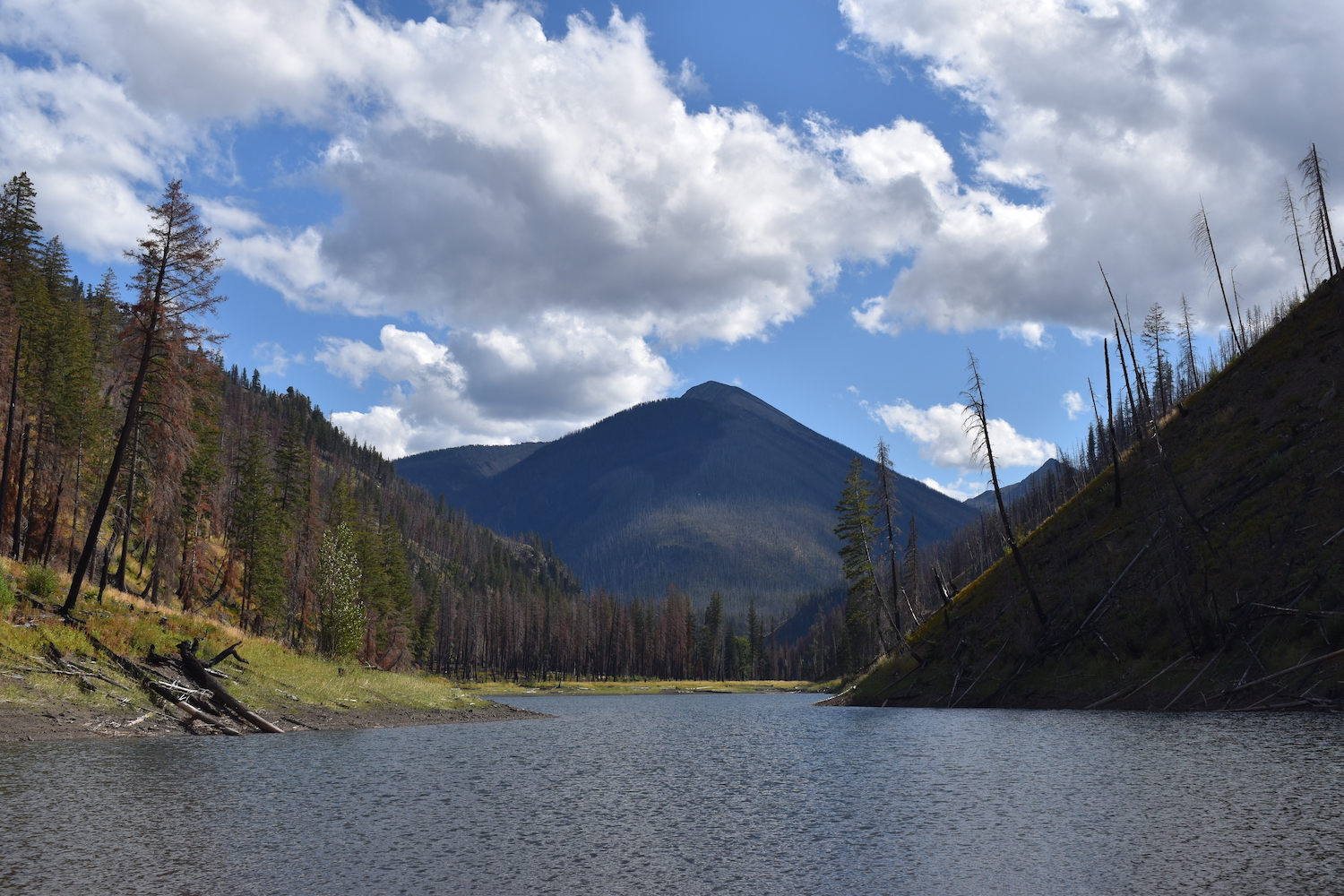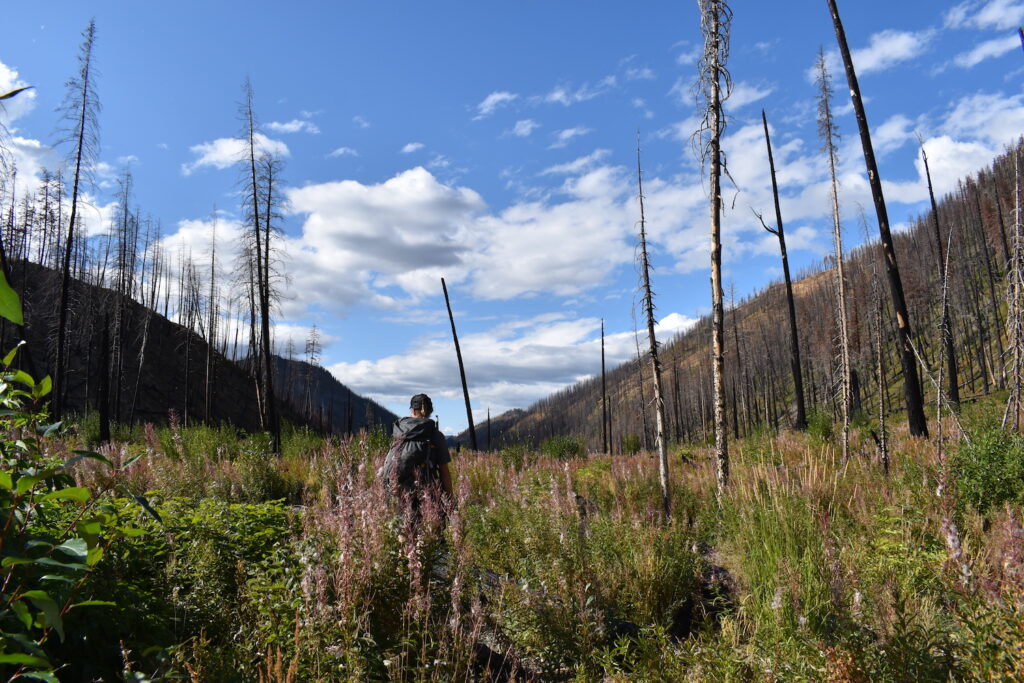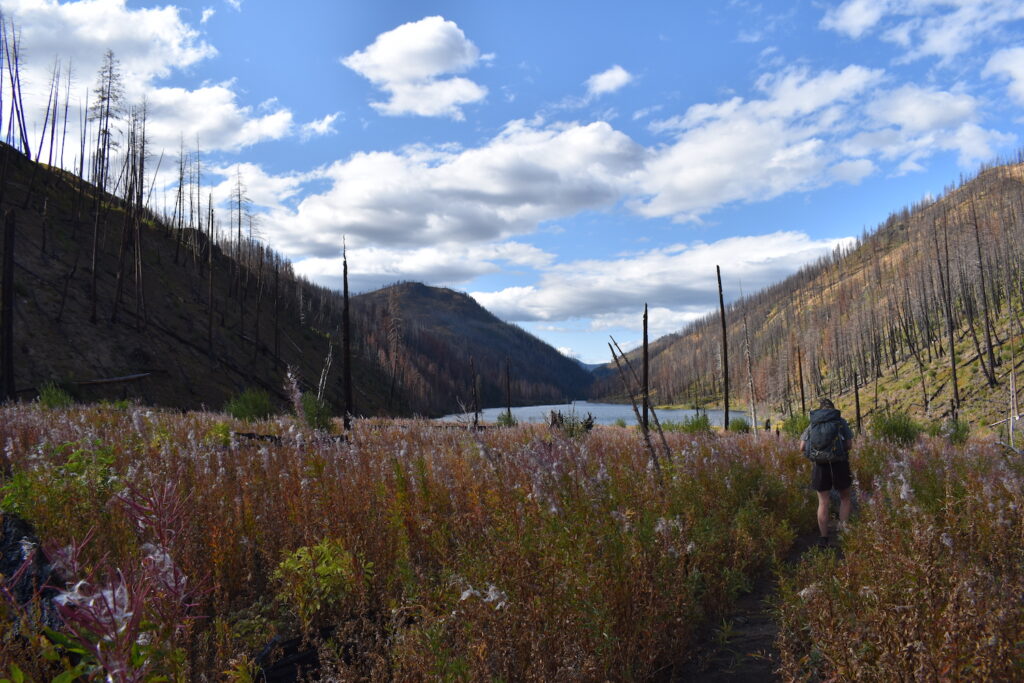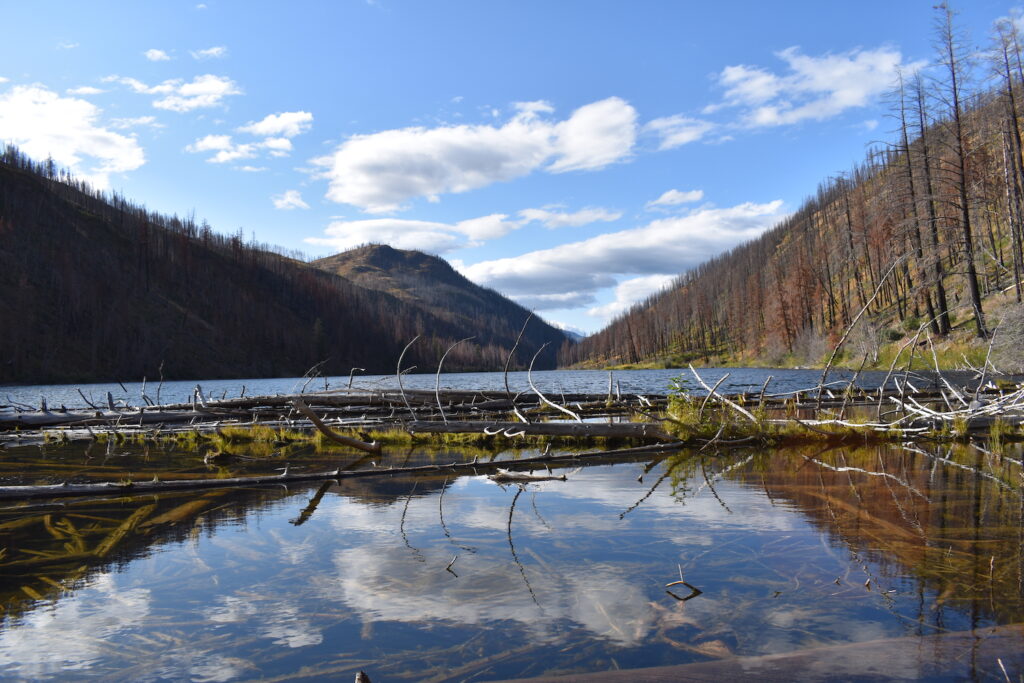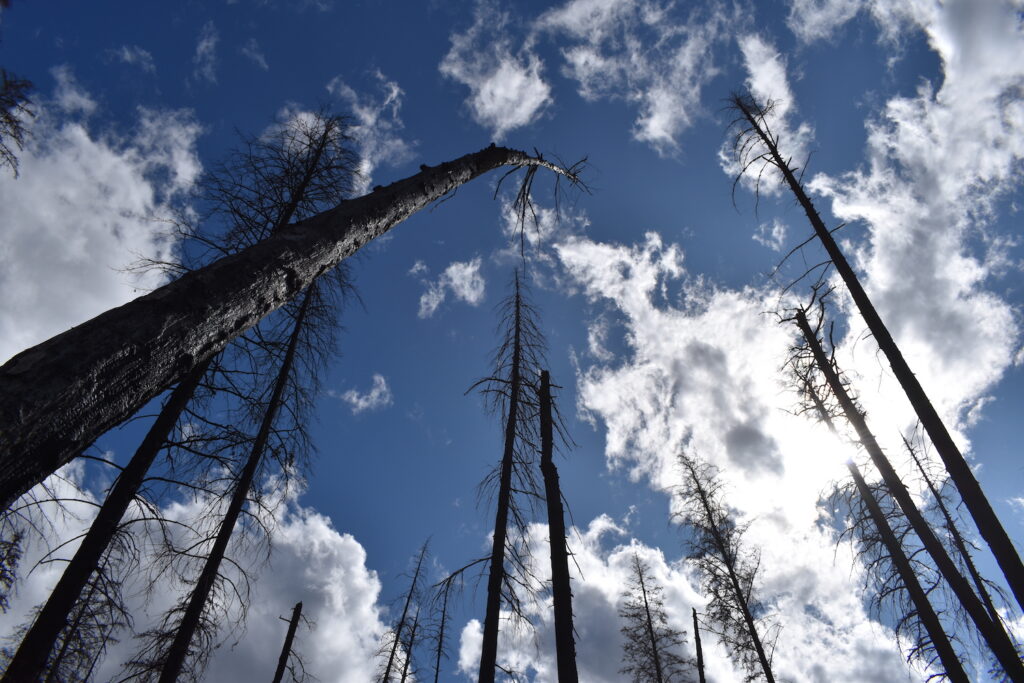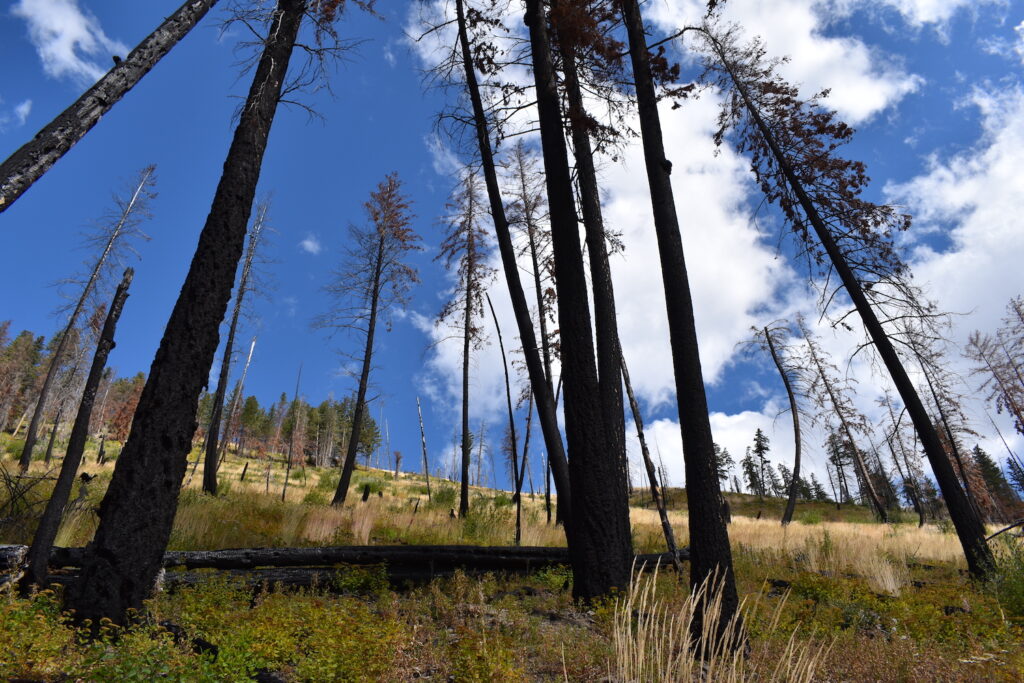Nature will bear the closest inspection. She invites us to lay our eye level with her smallest leaf, and take an insect view of its plain.
Henry David Thoreau
It’s no secret to most who know me that the Pasayten Wilderness, which spans over 531,000 acres on Washington’s northeast border with Canada, is one of my favorite places to explore.
Full of gorgeous lakes, high alpine tundra, and nearly 150 peaks over 7,500′ in elevation, the Pasayten’s biodiversity is a marvel. It’s home to an astounding array of wildlife, including the largest population of lynx in the lower 48 as well as deer, moose, mountain goats, bighorn sheep, and wolves. Even the elusive grizzly may roam here.
The wildness of the Pasayten is unparalleled in Washington and when you step inside its boundaries, it’s a place without time. Wandering this country gives you a glimpse of what frontier life might have been like.

At the very end of August, I spent 6 days backpacking over 80 miles inside the Pasayten, first completing a stunning solo backpack loop around Devil’s Dome on its west side, then joining up with a friend to explore around the Hidden Lakes of the central Pasayten.
The Pasayten’s Hidden Lakes, an unexpected trip.
Far up the Lost River Valley of the Pasayten, only 10 miles south of the Canadian border, lie a chain of four gorgeous lakes: Cougar Lake, First Hidden Lake, Middle Hidden Lake, and Big Hidden Lake. Interestingly, Big Hidden Lake drains north to Canada while the rest of the lakes drain south to the Methow via Lost River. The area has been long storied for its beauty and trout fishing, but was severely impacted by the 128,000 acre Diamond Creek Fire in 2017.
The Hidden Lakes and Billy Goat area of the Pasayten had been on my radar for many years, but I hadn’t planned to get there on this particular trip. My original plan was to meet my friend Laurel in Winthrop after completing Devils Dome, then head out for a 45 mile backpack through the Cathedral Pass area further east. The reality? I got caught a bit unprepared by weather on Devils Dome my last night and hiked out hours later than expected with completely soaked gear. I wasn’t quite reorganized to hit the trail again early Saturday morning.
Instead, Laurel and I met for breakfast, then poured over maps while I dried my gear in the sun at Pearrgyin Lake State Park. Laurel works full time with Conservation Northwest specializing in Conservation Restoration Ecology. We found ourselves drawn to the Billy Goat and Hidden Lakes area of the Pasayten. Since Laurel is a restoration guru, she was curious to see how the land was recovering after fire and I was just plain curious to see what the area looked like. In short time we had a plan B: a 35 mile out and back from the Billy Goat trailhead to Big Hidden Lake. It sounded like most of the trail had been logged out as far as First Hidden Lake, but beyond that we had no idea what we’d find.
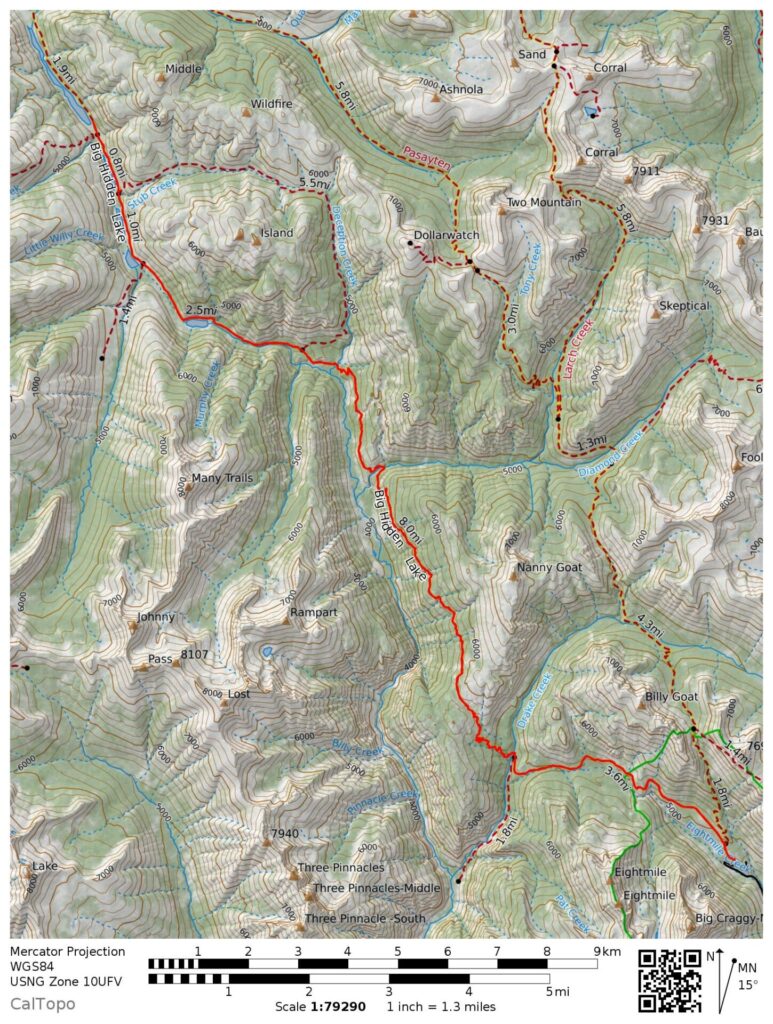
Day 1: Billy Goat TH to Cougar Lake
Distance: 13.8 miles | Elevation Gain: 3,150′
Getting to the Billy Goat trailhead is a small adventure in and of itself and takes roughly an hour from Winthrop. After driving 9 miles north on the West Chewuch Road, you continue another 17 miles on Forest Road 5130, which branches off the Chewuch at the 8 Mile Sno-Park. Back in September roads were in reasonable shape with only some light washboarding.
The last mile to the trailhead turns a bit rougher and narrow. Horse trailers and larger or low-clearance vehicles park at the lower trailhead but most cars should be able to make it all the way to the end.
We didn’t arrive until midday on the Saturday of Labor Day weekend and fully expected a sea of cars. Instead, there was only one other car, a forest service vehicle, and a mule train at the lower trailhead. It wasn’t clear if the mules were coming or going, but we were surprised and delighted for this much solitude on a holiday weekend!
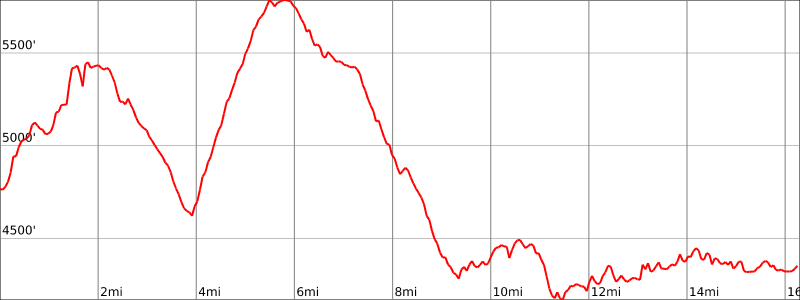
From the Billy Goat trailhead, the Hidden Lakes trail climbs roughly 700 feet over 2 miles along the eastside of the Eightmile Creek drainage with big views of Big Craggy and Eightmile Peak to the west. The views are even bigger now that the trees have sadly been burned into matchsticks. It was sobering to see the charred landscape.
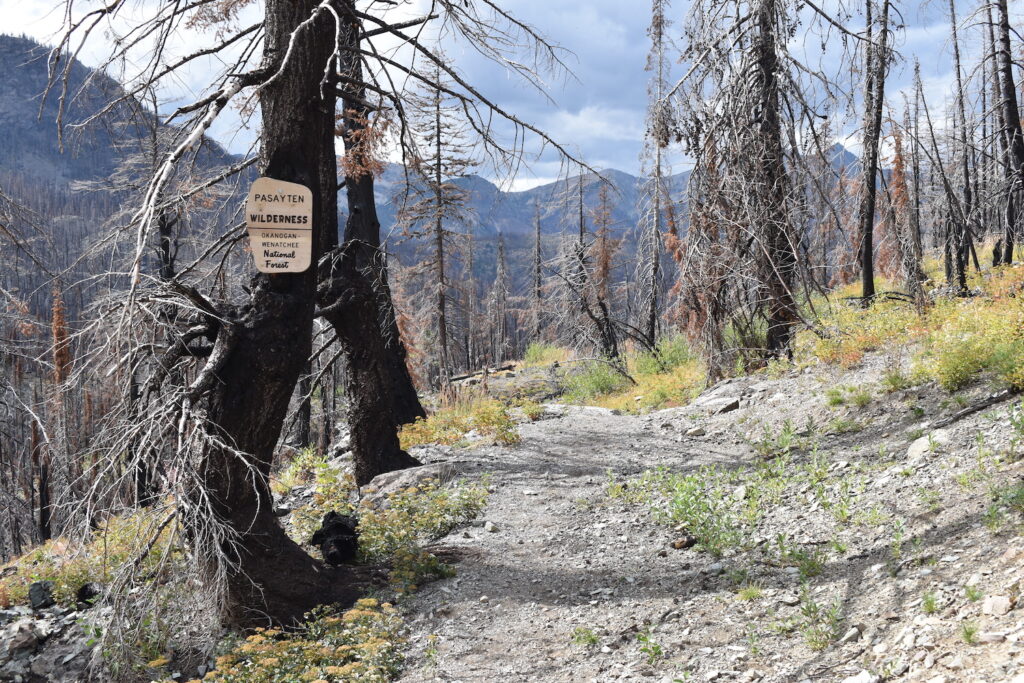
A charred landscape. 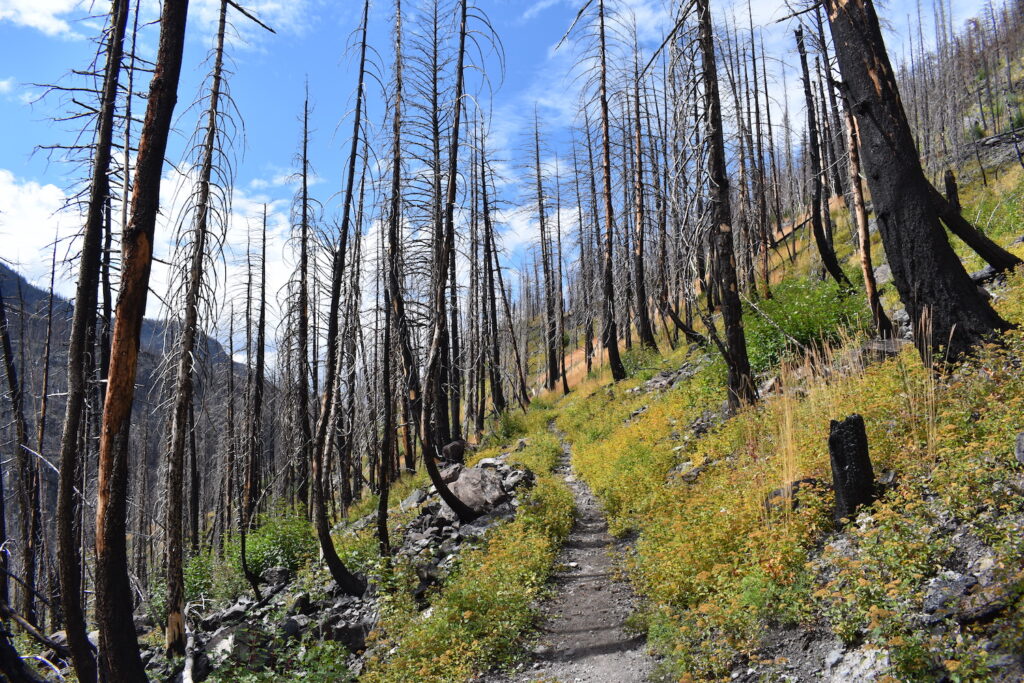
So much burned forest. 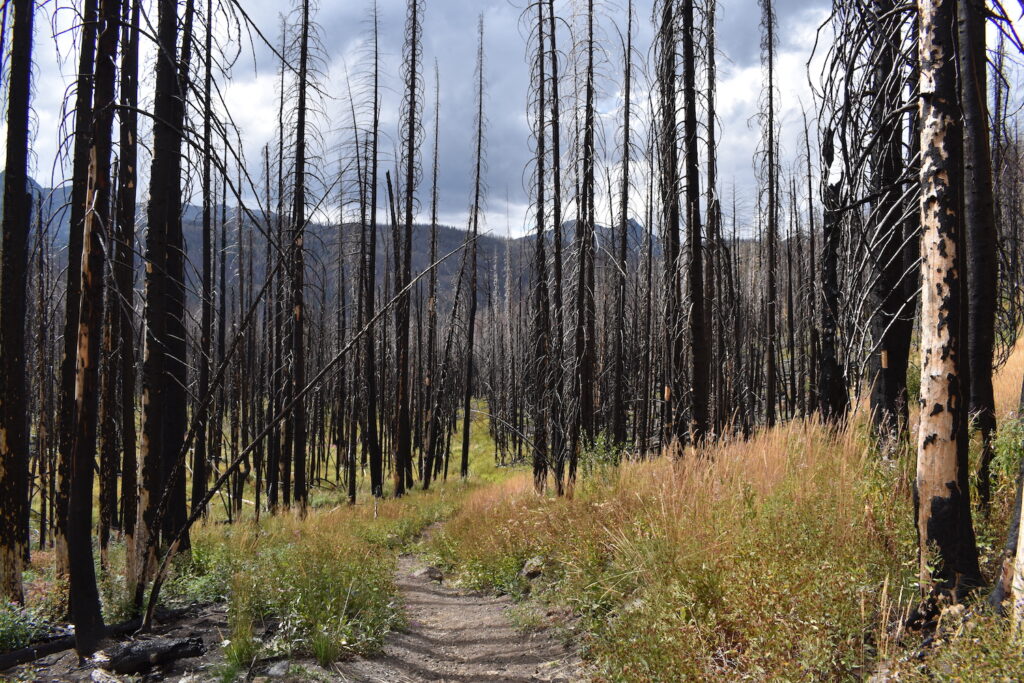
Matchsticks.
Once at Eightmile Pass, the trail descends 1,000 feet in the next 2 miles down to Drake Creek. The bridge at Drake Creek was burned out in the fire but the water was low enough that the crossing only required a few acrobatic hops across some logs and rocks.
It’s clear there used to be scattered campsites and horse camps between the trailhead and Drake Creek, but most are now blackened and surrounded by scorched, unstable snags.
After Drake Creek, the trail climbs again another 1,000 feet in the next 1.5 miles to Lucky Pass, with beautiful views of the Lost River Valley. Lost Peak, Pass Butte, and Many Trails Peak dominate the landscape. After Lucky Pass, the trail has a few small rollers before making a big descent 1,500′ over the next 3.5 miles to Diamond Creek, just past the 9 mile mark.
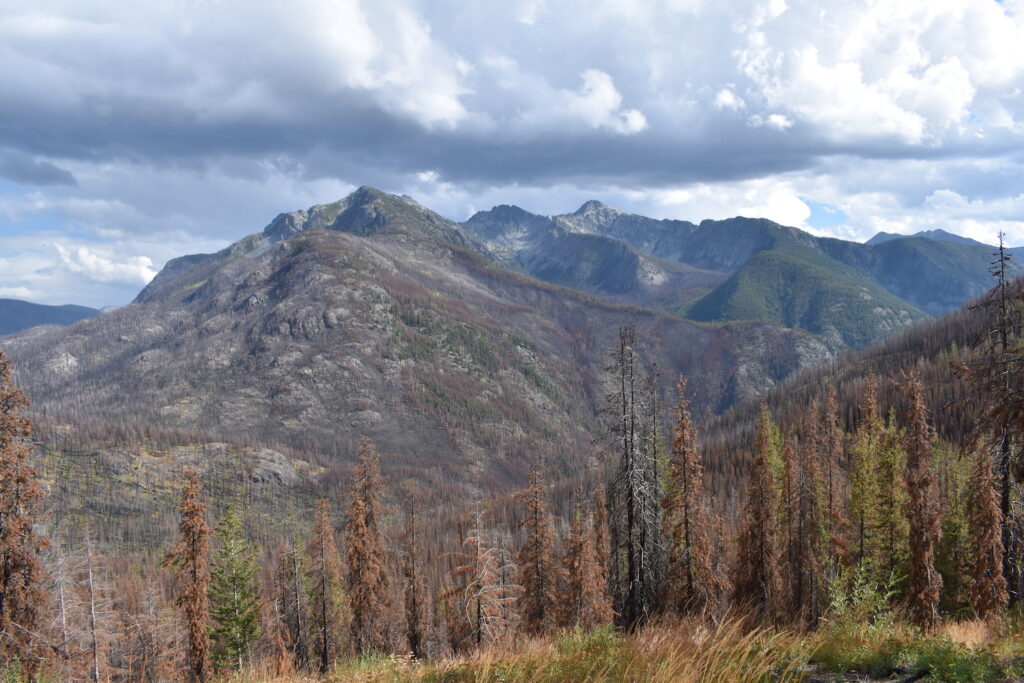
Views of Many Trails Peak from near Lucky Pass. 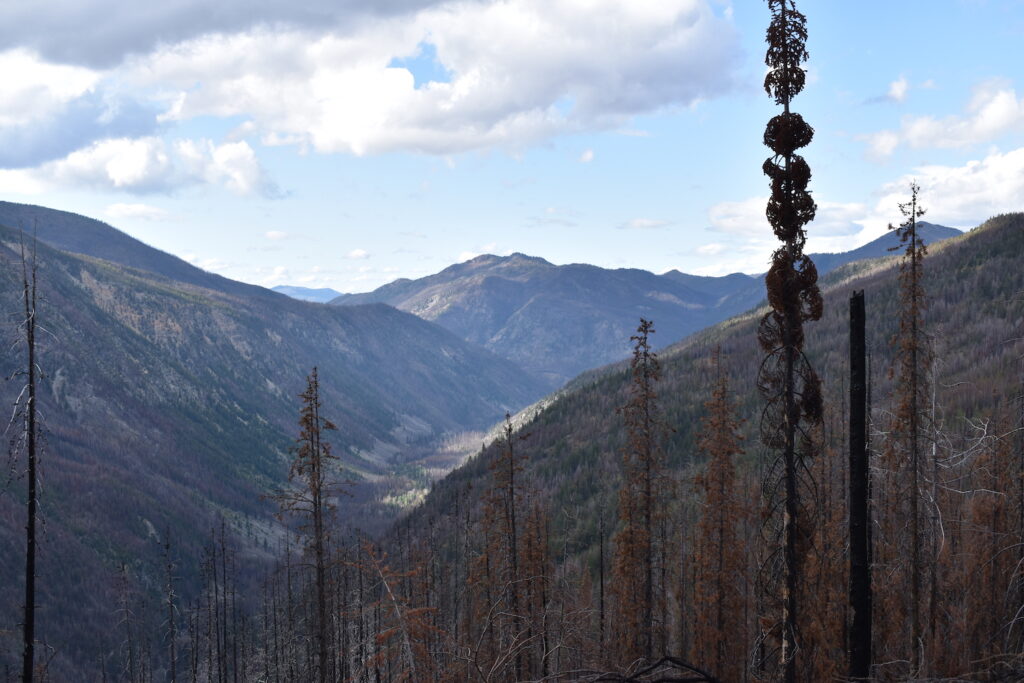
The Lost River Valley.
The Diamond Creek bridge was protected during the fire and is surprisingly still intact. There’s a small camping area right off the trail with easy access to water, but it’s surrounded by a lot of soot and burned, unstable trees. We had originally planned to camp here for the night but decided to push on a few more miles to Cougar Lake to see if we could find a safer and more private camp spot.
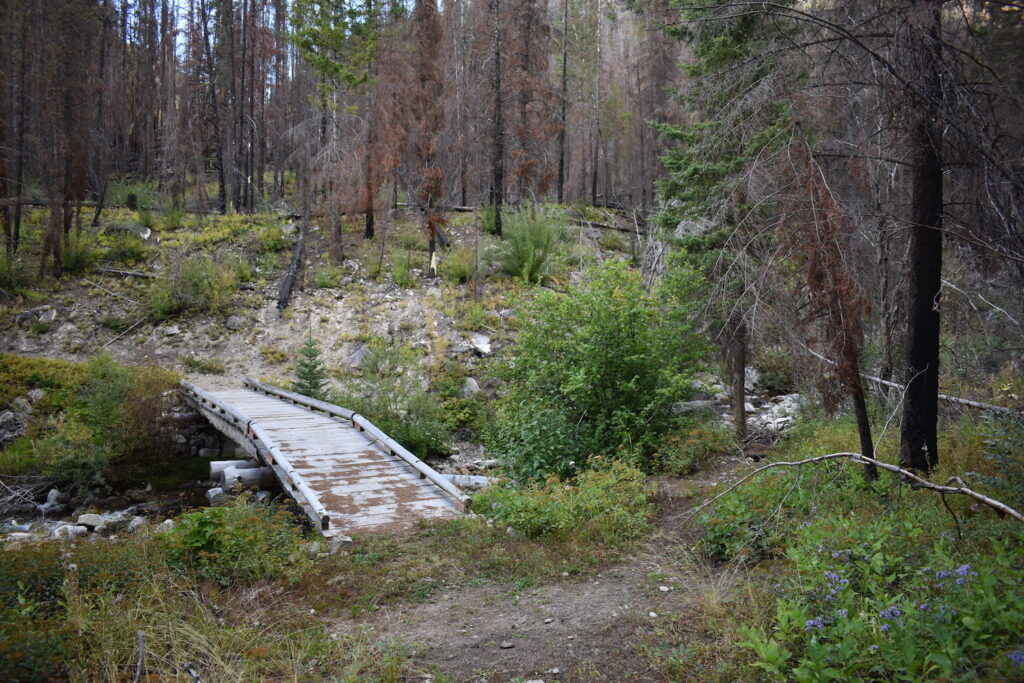
The bridge at Diamond Creek, near where the 2017 fire started, is surprisingly still intact.
Most of the trail to Cougar Lake after Diamond Creek traverses below Island Mountain and has minimal climbing, which I was thankful for! My legs were now approaching 60 miles and close to 15k in 4 days. I was ready for a relaxing evening at camp!
Nearer Cougar Lake, the appropriately named Lost River disappears underground and is replaced by a spectacularly green marsh. To see any green in this badly burned landscape was refreshing and we couldn’t help but admire it. Being the wildlife geeks we are, Laurel and I chatted out about what might be down there. It was perfect moose and beaver habitat.

The trail turned slightly brushy, and unfortunately, wet. Earlier in the day we had heard some distance rumbles of thunder and now it was clear where it had rained. 12 miles in and barely a mile from camp and my shoes and pants were soaked through in no time.
Laurel and I reached the east bank of Cougar Lake just as darkness fell and switched on our headlamps to scope out a camp site. Right along the trail were two enormous horse camps with safe unburned trees and lots of rocks and logs for lounging. There wasn’t another soul around.
I was soggy and cold as we unpackeded camp, then Laurel asked, “would you like a margarita?”
I was certain I had heard wrong.
“Huh?” I responded, convinced my ears were playing tricks on me.
I watched in amazement as Laurel pulled margarita mix, limes, tequila, guacamole, and fresh carrots from her pack. I couldn’t believe it! Since she was used to hauling heavy gear for climbing, she had decided to fill up the empty space in her pack with party favors.
“Uh, yes please!!”
My soggy mood was immediately bolstered and I kicked off my wet shoes and relaxed on a log. We spent the evening sipping margaritas while hearing the eerie and haunting calls of loons from the lake. What an evening.
Day 2: Cougar Lake to Big Hidden Lake and back
Distance: 7.3 miles | Elevation Gain: 1,270′
We awoke to a freezing morning and took our breakfast, hot tea, and coffee up the trail to a sunny clearing along the lake. Most of the forested slopes were burnt to a crisp, but pockets of green trees still remained here and there. Cougar Lake was peacefully beautiful in the light of day and the air was full of the tiny meeps of pika. From the sound of it, there was a pretty healthy pika population living in the surrounding talus fields that had survived the fire just fine!

Beautiful Cougar Lake. 
That talus slope had lots of healthy pika!
We decided to keep our cozy camp at Cougar Lake and day hike to Big Hidden Lake with lighter packs. I was happy to give my legs a break and since it was only 3 miles to the upper lake, we’d have all day to explore.
From the trailhead all the way to Cougar Lake, the trail had been in surprisingly good condition. Some fire erosion had caused a few narrow spots, which for hikers isn’t a problem, but I’d certainly be a bit nervous with stock. The work that’s been done to clear the trail is impressive.
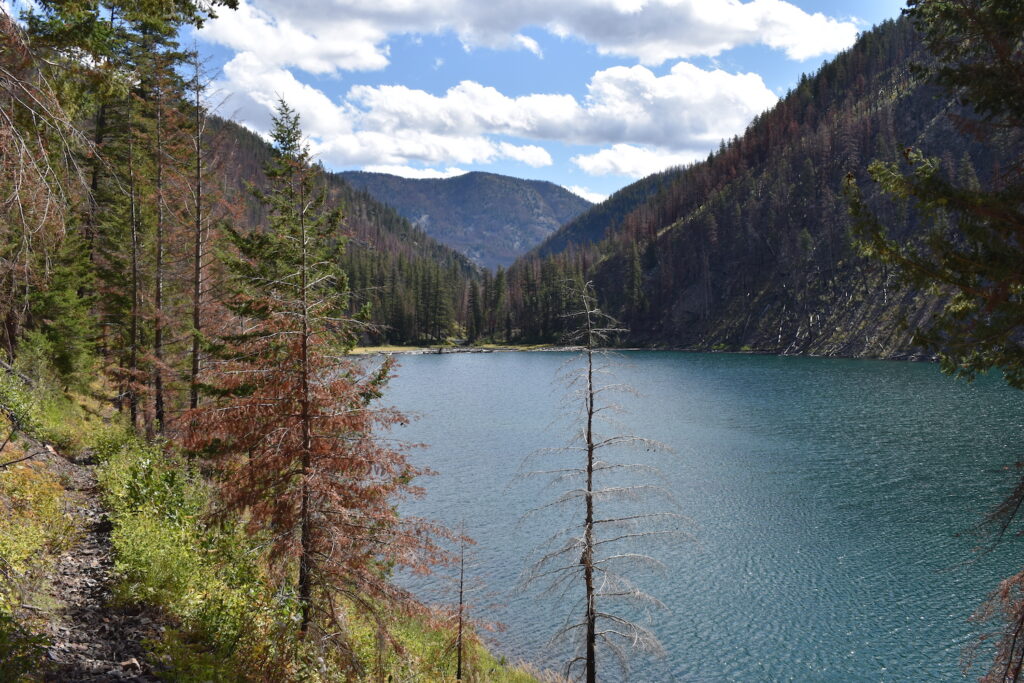
Hiking along Cougar Lake. 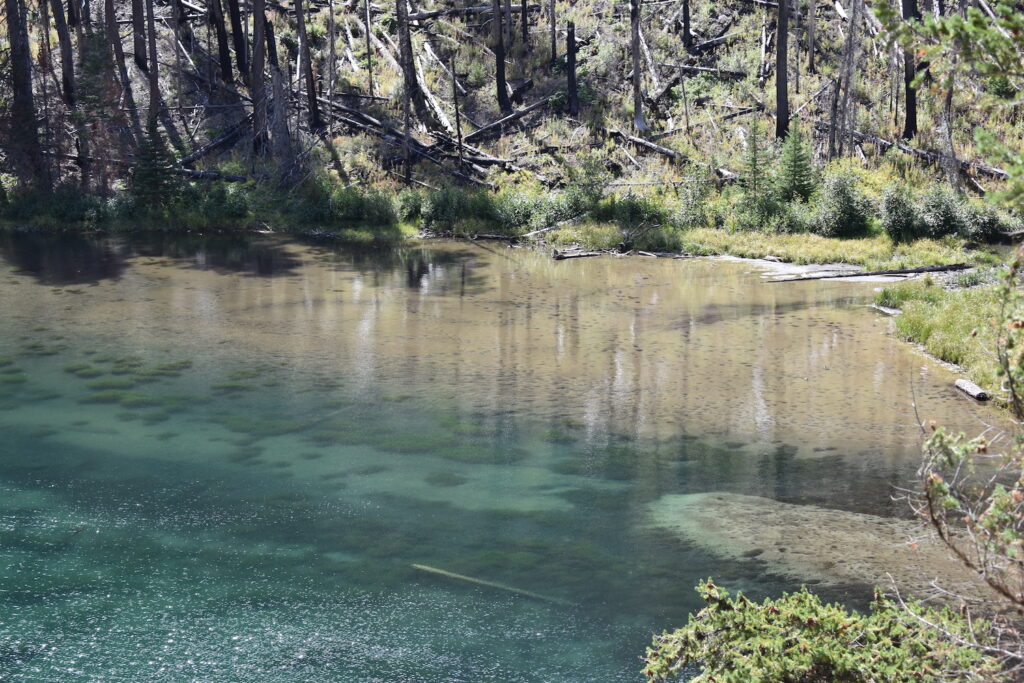
The west end of Cougar Lake. 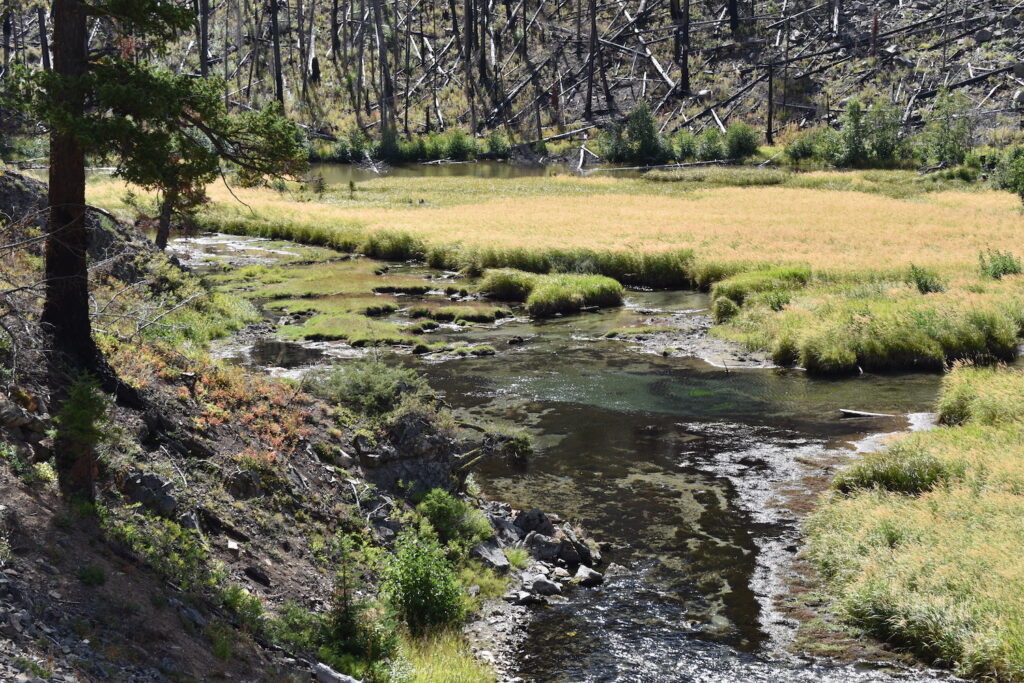
Beautiful riparian habitat between Cougar and First Hidden Lake. 
Trail conditions were surprisingly good.
When we reached the south end of First Hidden Lake, we saw tons of animal tracks in the dried end of the lake bed, just like the west side of Cougar Lake. Without hesitation Laurel and I climbed down the rocky slope to get a closer look. We were in wildlife geek heaven and could barely contain our excitement.
This lake bed was such a delightful surprise and in it we found the tracks of moose, deer, and a black bear. Once we turned our focus to the actual lake, we noticed a huge school of trout, floundering and trapped in the small receding pool of water left. The lake was low and completely cut off. They had nowhere to go and with bear tracks extending into the lake, it was clear the trout were likely providing an easy snack for a lot of critters.
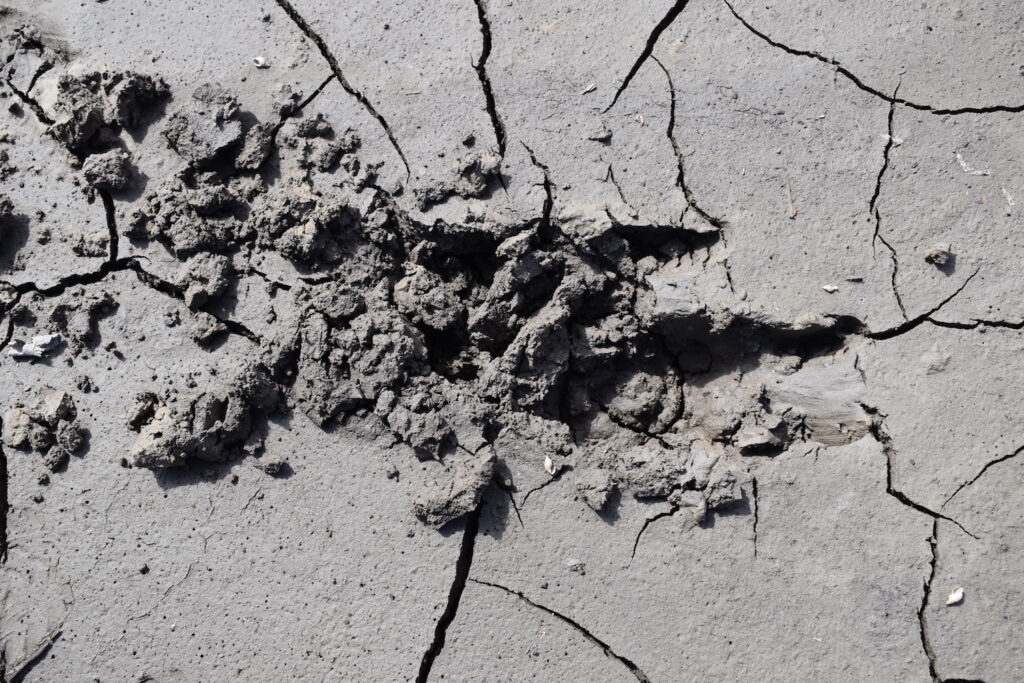
Deer tracks and evidence of pronging. 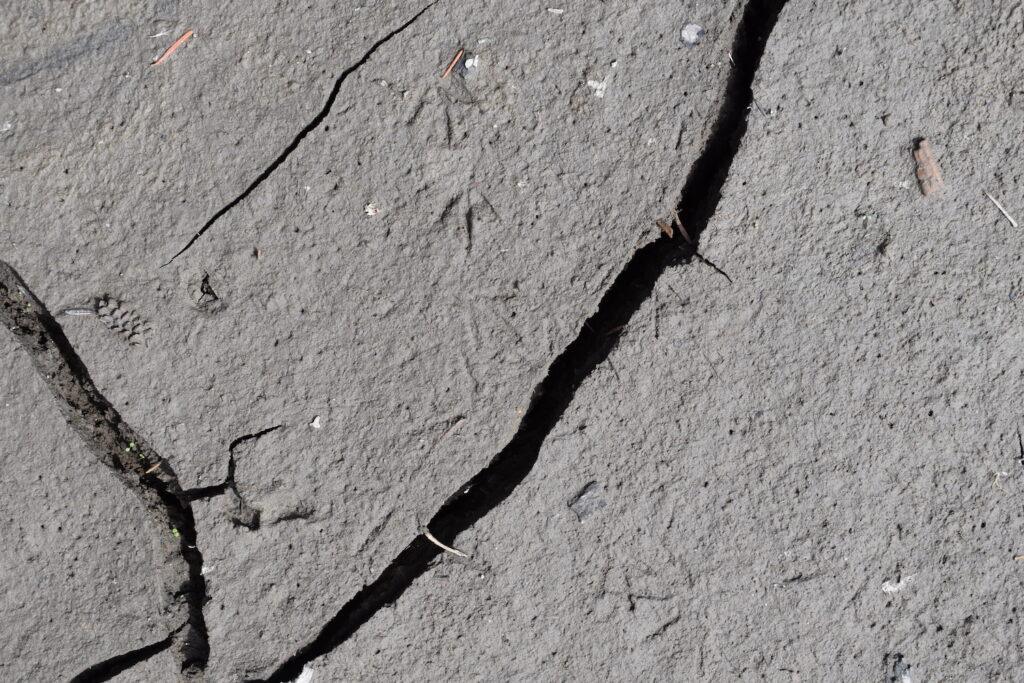
Tiny bird tracks. 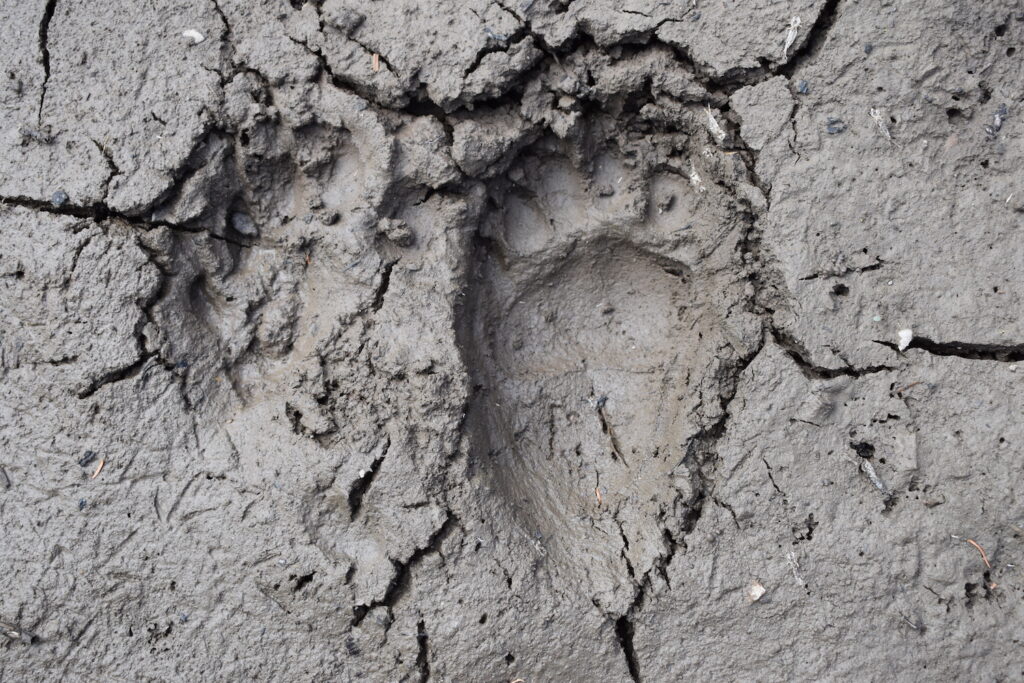
Black bear hind foot. 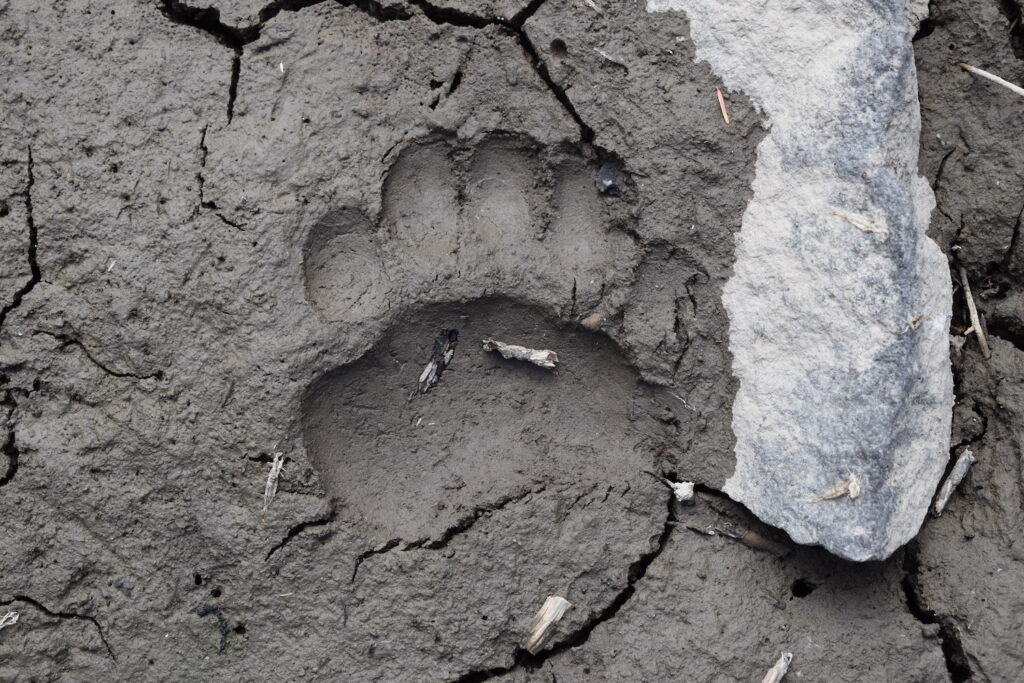
Black bear front foot. 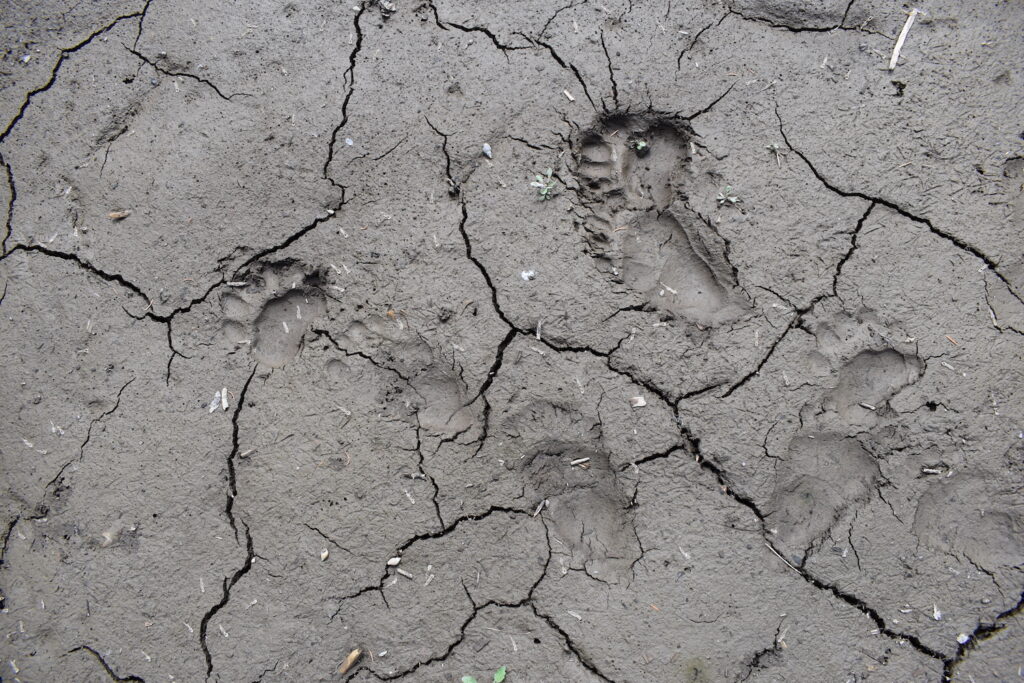
More black bear tracks.
What I’ve loved most about getting involved with Conservation Northwest’s tracking program is that it really opens your eyes to the wilderness around you. Even if I don’t see live animals, I see wildlife everywhere through their tracks. I see all the different species that use the land, how they move and how they behave, and even more amazingly, how they all overlap.

A gorgeous view back to Many Trails Peak from First Hidden Lake. 
Laurel discovered the entire lake was draining underground.
After sleuthing out and identifying all the tracks, Laurel discovered that the lake was somehow draining underground. I guess it makes sense if the Lost River is indeed subterranean in places. We headed back to the trail and continued on, finally reaching the historic cabins between First and Middle Hidden Lakes at Stub Creek, which were wrapped and saved from the fire.
The trail was in good condition all the way but after the cabins, it was a maze of fallen trees. There was no sign of any of the intersecting trails leading up Stub Creek or to Tatoosh Buttes. They’ve clearly been burned away. We stopped at the cabins for a lunch break and explored the area.
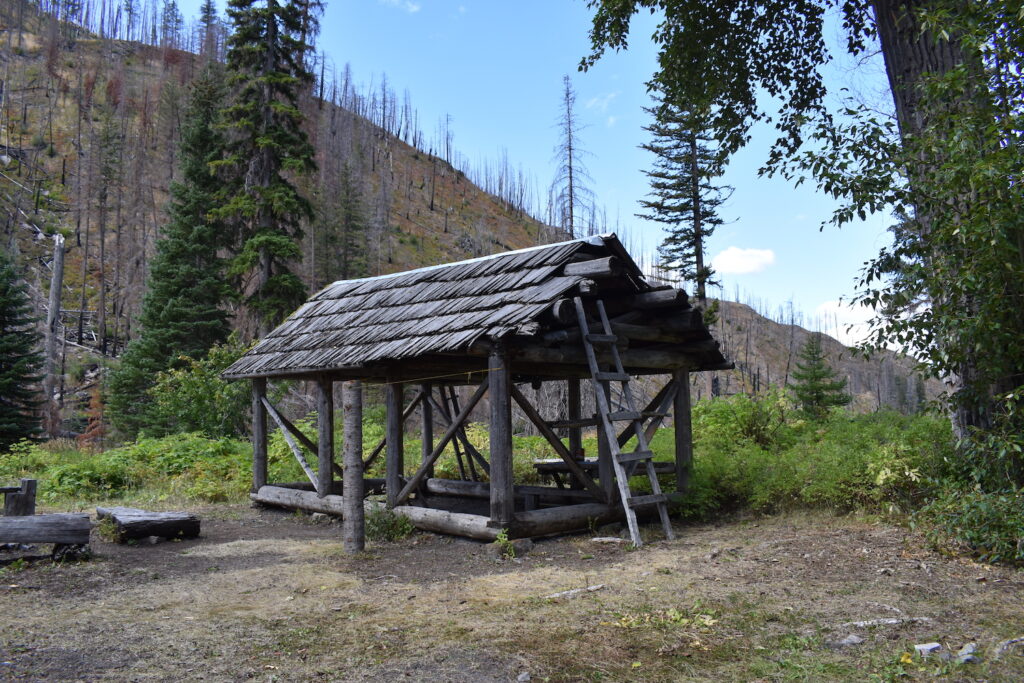
The large horse camp area at Stub Creek. 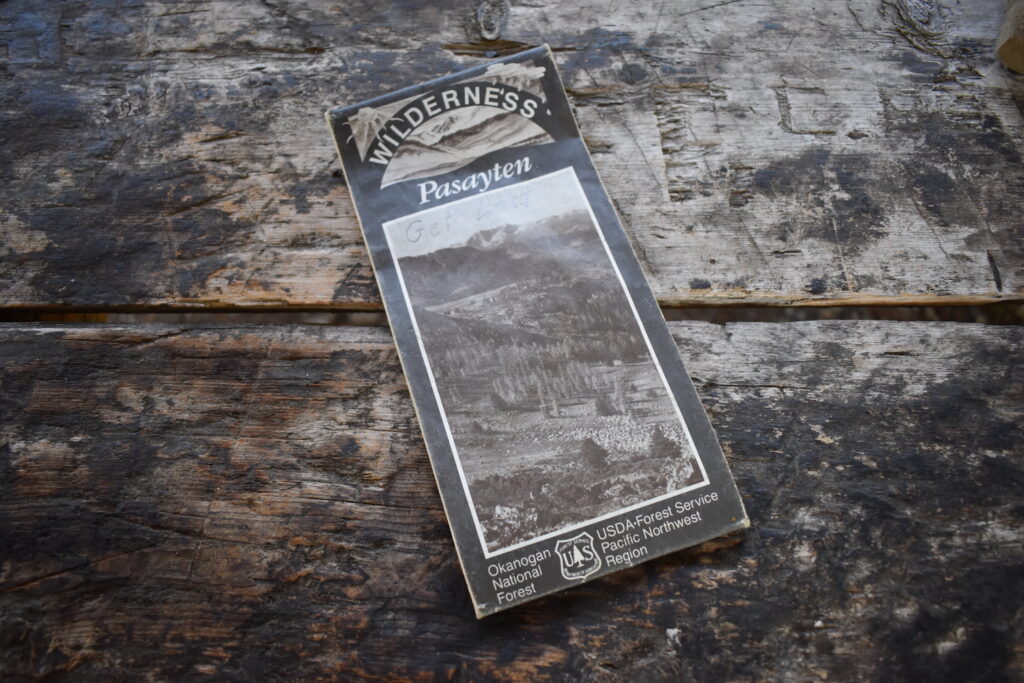
An old map from the 80s. 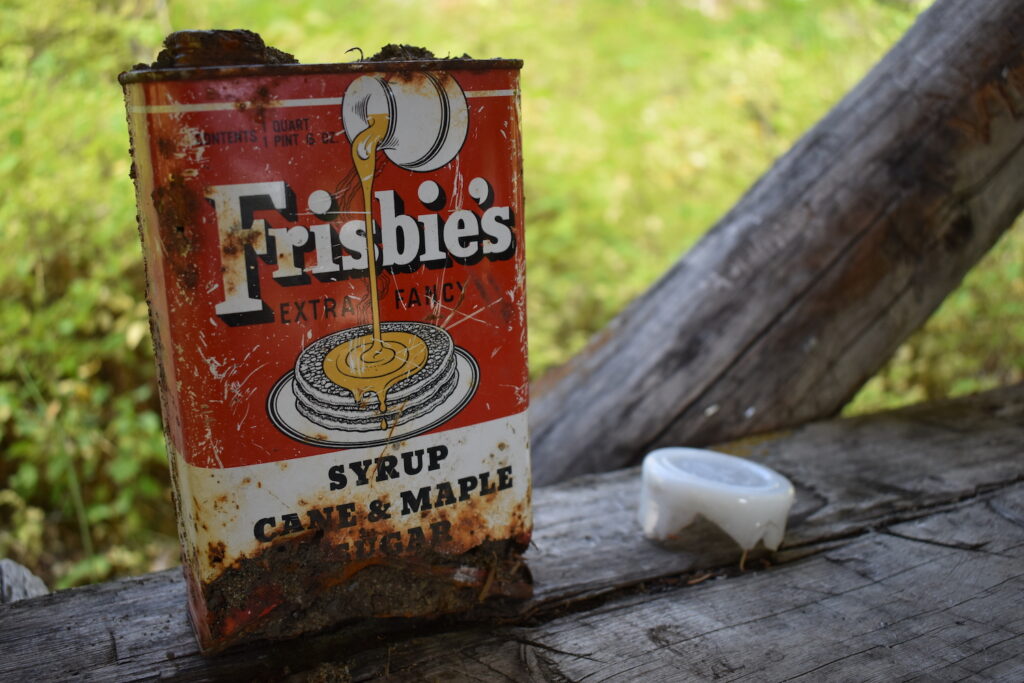
These were made in the 60s in Spokane, Seattle, and Portland. 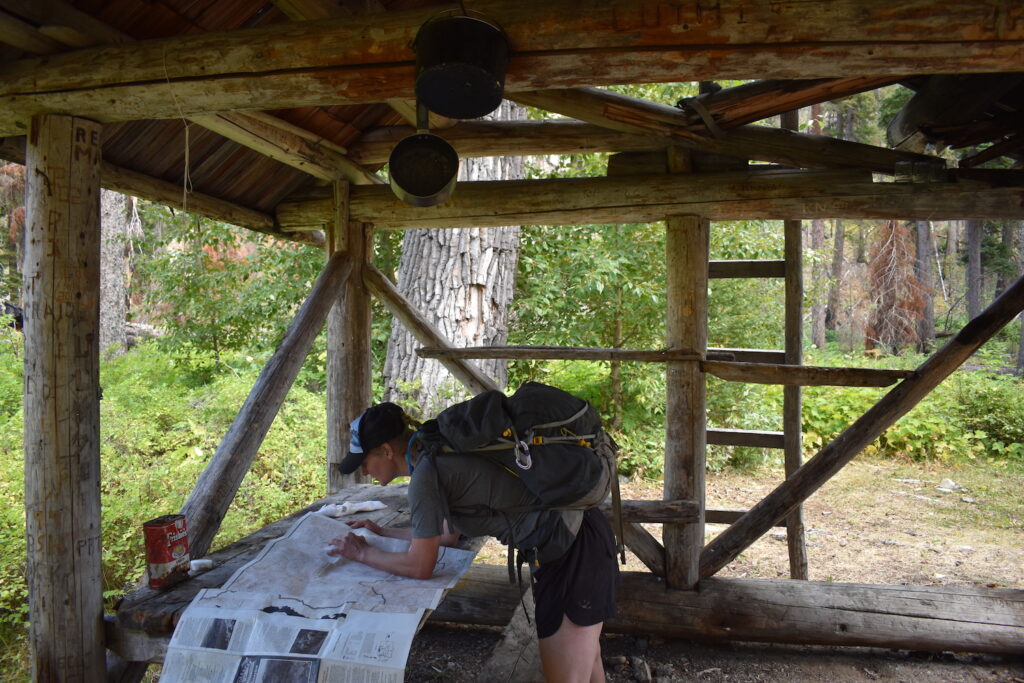
Laurel checking out the old Pasayten map. 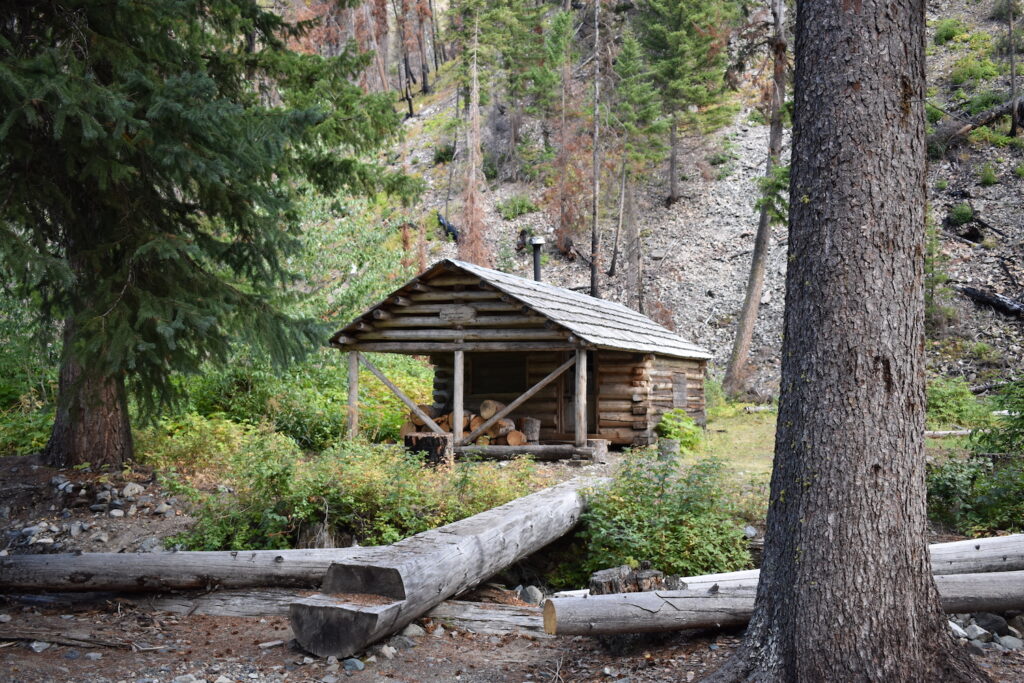
The guard station build in 1954. 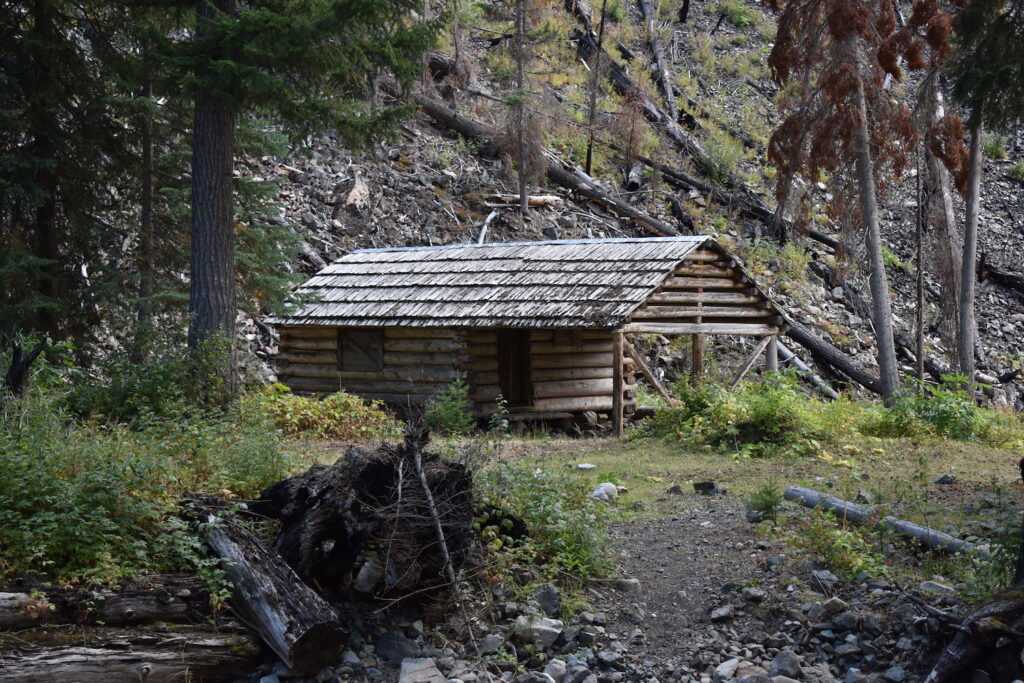
The second cabin was sadly in very poor condition. 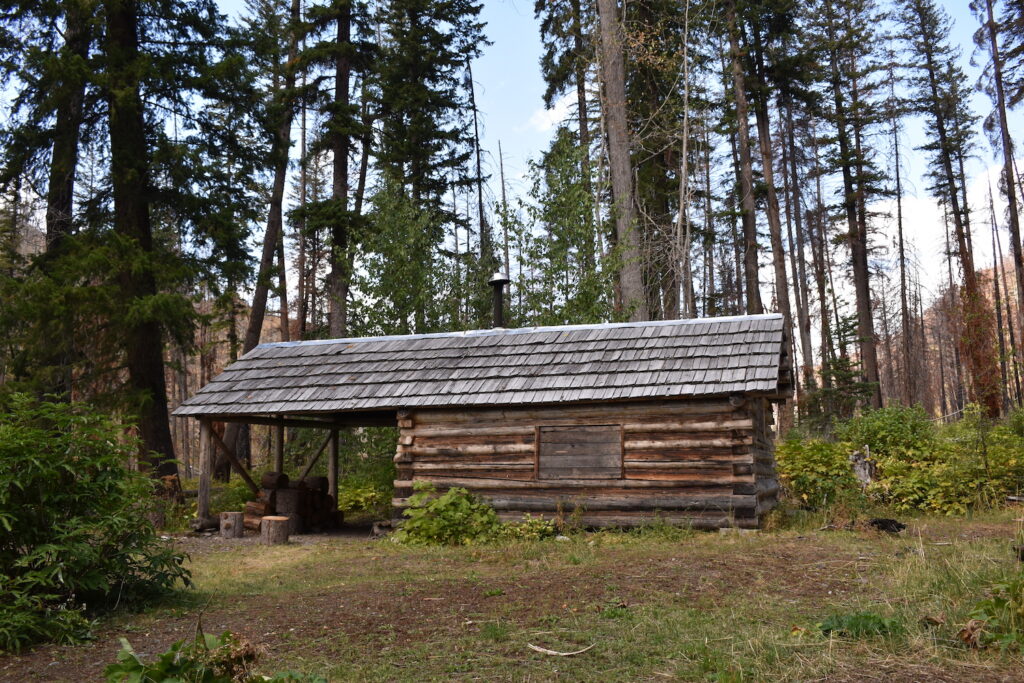
The main guard station and maintained cabin. 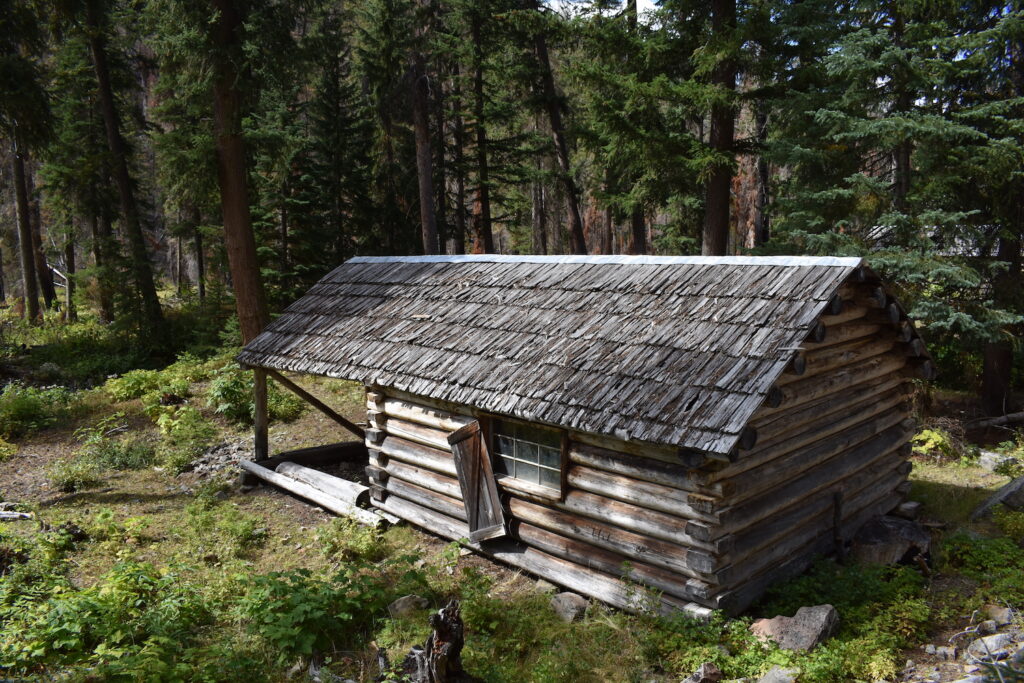
This second cabin needed a lot of attention. It was spilling over with mouse and rat feces.
Not deterred by a little tree hopping and route finding, we continued along Middle Hidden Lake and yet again, took a long break to explore more tracks in the dry lake bed. Middle Hidden turned up even more critters that included coyote, otter, and possibly even mink. Very exciting!
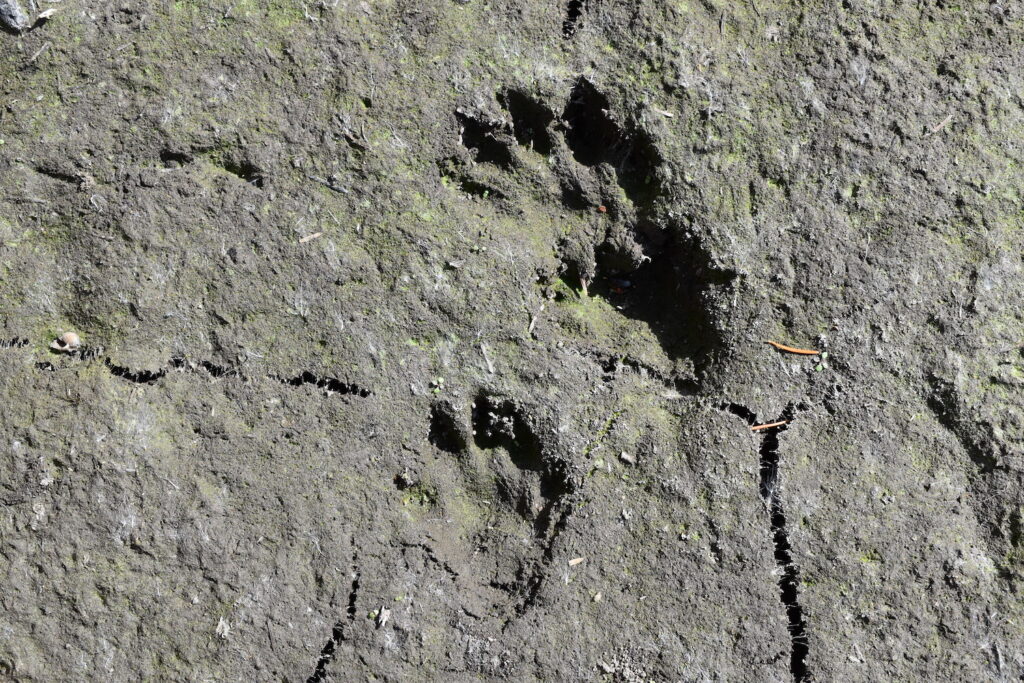
Otter! 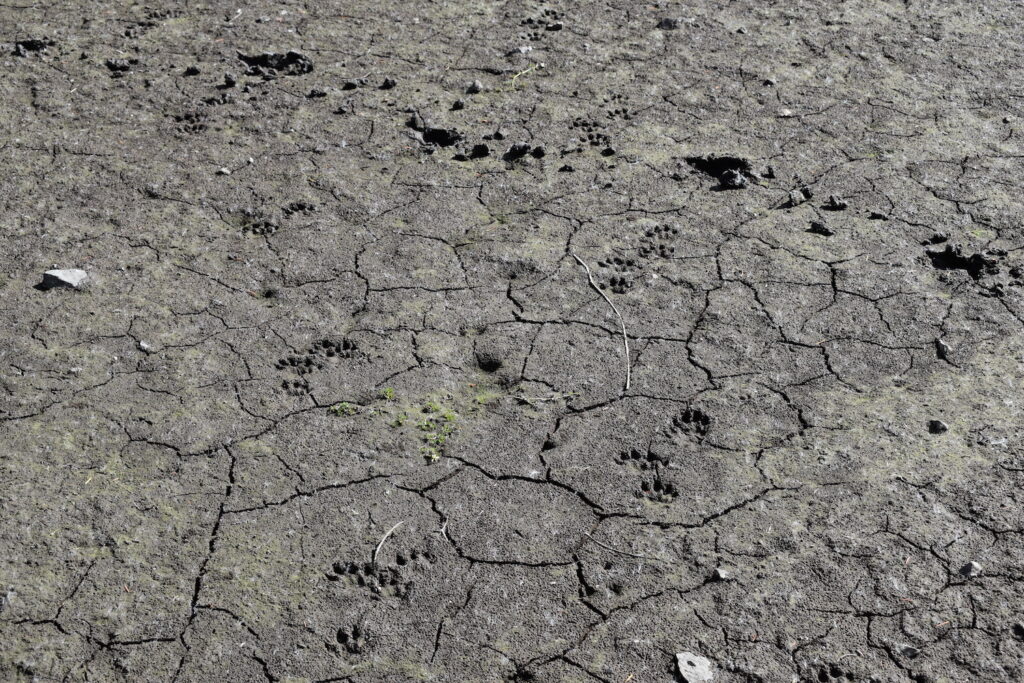
Likely that two otters made these tracks. 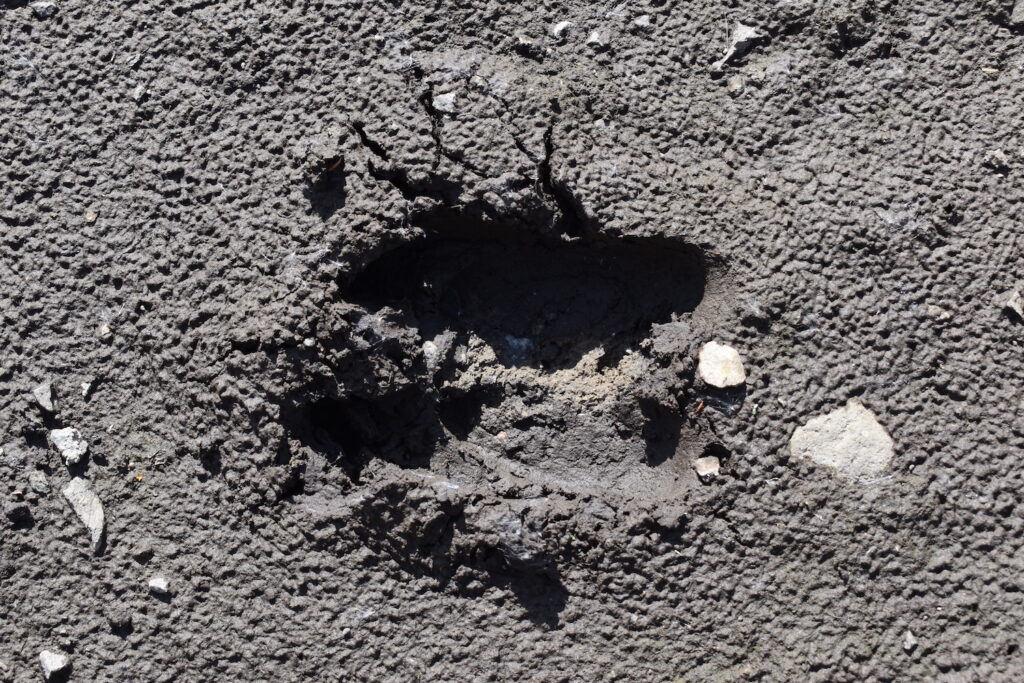
I did a bad job with scale but this is moose. 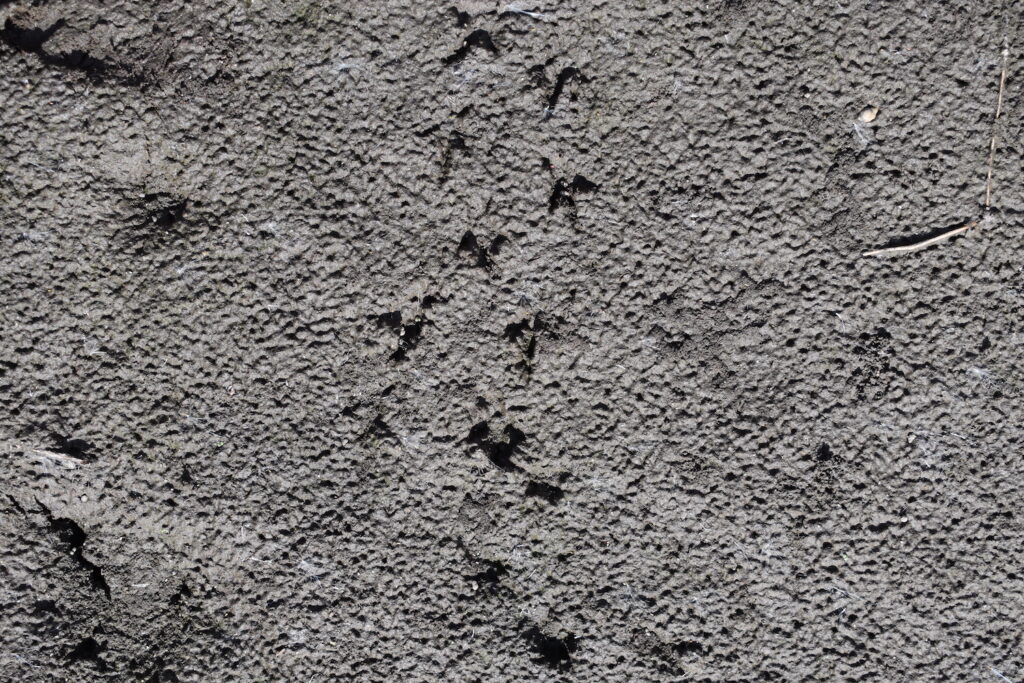
Yet to be ID’d bird tracks. 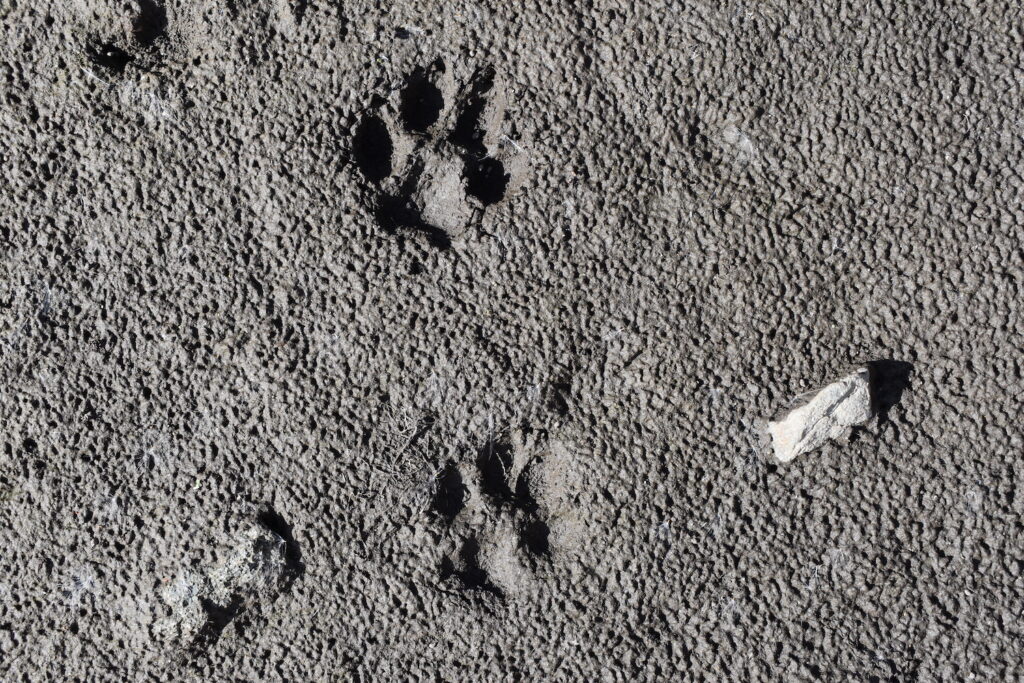
Coyote. 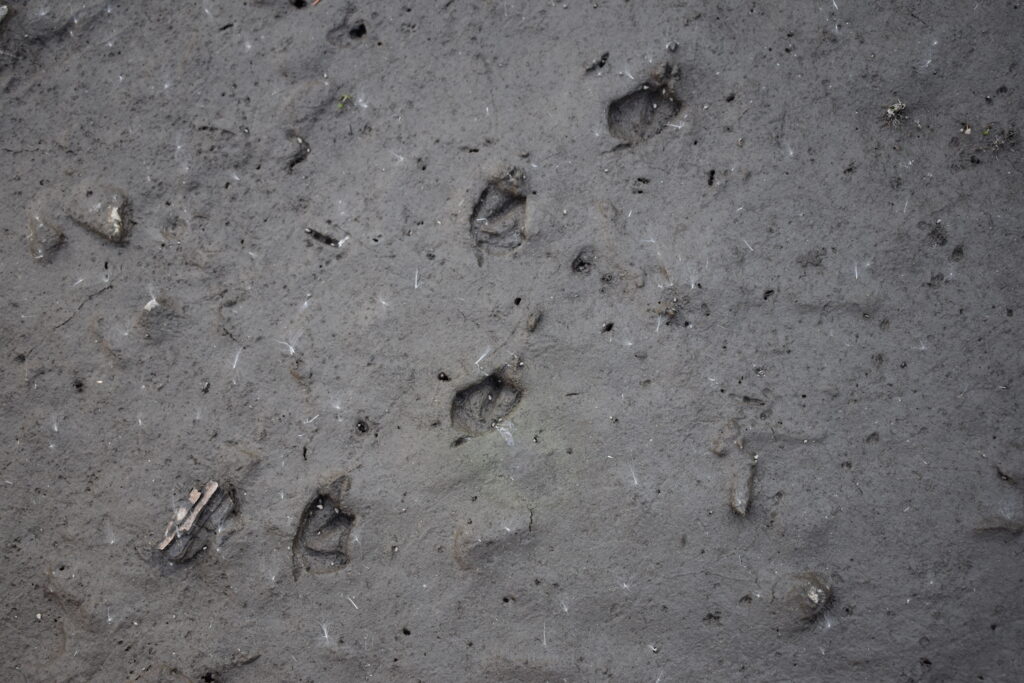
Duck tracks of some kind, likely Barrow’s Goldeneye since they were in the lakes. 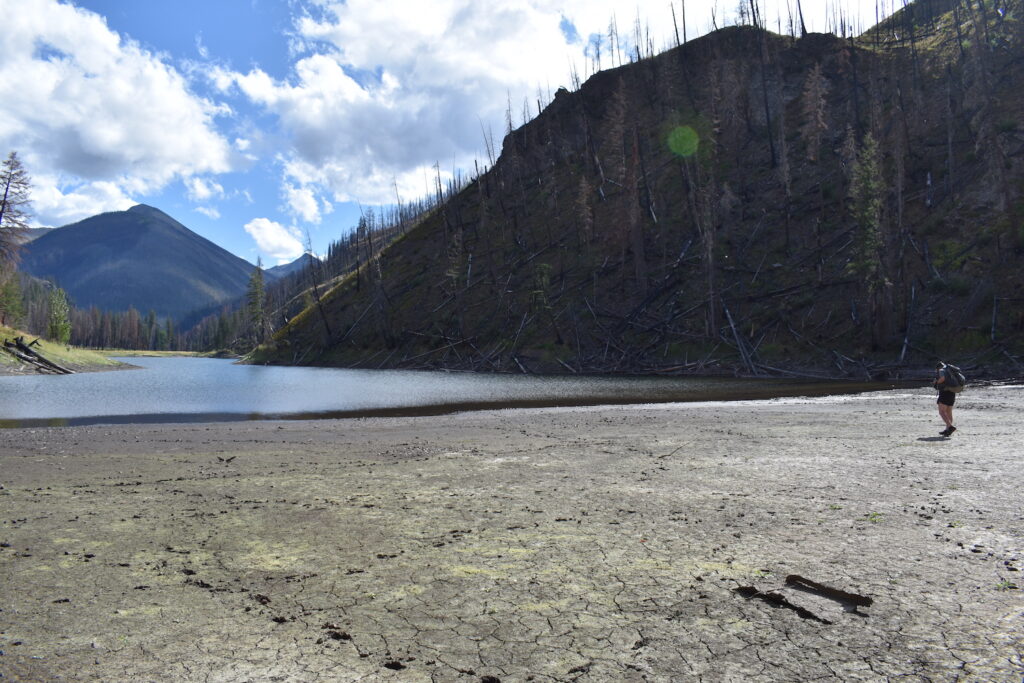
Exploring tracks in Middle Hidden Lake.
Eventually the trail all but disappeared and we picked the path of least resistance through the trees and debris, at last arriving at the shore of Big Hidden Lake, which stretched gorgeously far into the distance.
Aside from a couple we passed back near the historic cabins, Laurel and I had seen no one else all weekend. We sat down, enjoying the amazing solitude, the huge views stretched out before us, and the unbelievable blue sky. Behind us was Many Trails Peak, towering over the landscape. We found tiny underwater snails on the logs, saw trout jumping from the lake, and could have stayed here for days, soaking it all in.
When it was finally time to return to camp, we reluctantly gathered our gear, not really wanting to leave this magical place. Despite the scars, it was breathtakingly beautiful.

Leaving Big Hidden Lake. 
Looking back north towards Canada. 
Beautiful views all the way back to camp. 
Such spectacular riparian habitat. 
Cougar Lake nearing sunset.
As we approached our camp at Cougar Lake, we heard a distinct slapping sound on the water. The unmistakable sound of a beaver! Of course wouldn’t you know? I left my telephoto lens at the trailhead. We watched giddily as he made laps all over the lake, slapping his tail as he went.
Day 3: Cougar Lake to Billy Goat TH
Distance: 13.9 miles | Elevation Gain: 3,745′
Laurel and I spent our last day at Cougar Lake lazily, not really wanting to leave. We took our breakfast to the sunny spot along the lake we visited the previous day and reveled in the solitude and beauty.
We soon heard flocks of small chirping birds in the trees behind us and realized they weren’t just flying over the lake, they were catching thousands of tiny little nymphs that were hatching from the lake and taking flight.
The morning light perfectly illuminated all of the little flying critters and we sat there for over an hour, watching this incredible dance of nature. Every once in a while a nymph would take flight and stay low, making it to the safety of the trees along the shore and we would cheer.
So much in nature goes completely unnoticed until you truly sit down, be still, watch, and listen. Most of us are so consumed with getting from point A to point B and marveling at the big grand vistas when we’re outside that we miss all of these tiny, magical moments that truly make nature a gift.

Mourning Cloak butterfly at our camp. 
The beautiful Lost River leaving Cougar Lake. 
Climbing back to Lucky Pass. 

I’ll only say this about our 13 mile return hike: boy that climb from Diamond Creek all the way back up to Lucky Pass is a beast! But as I hiked, I wasn’t really thinking about my legs or how tired they were from these 80 miles in the Pasayten. I was immensely relaxed, rejuvenated, and inspired by the wilderness and wildlife around me.
I’ve always believed that the more you look, the more you see. And every time I visit the Pasayten it opens all of my senses in a way no other place does. This magical land of wildness continually begs me to see more.
The humbling power of devastation.
Spending extended time in a wilderness that has been forever changed by fire is visceral. While fire is a very natural process in many wilderness areas, especially the Pasayten, the Diamond Creek Fire in 2017 was not natural. Human-caused carelessness transformed nearly 40% of this beautiful wilderness into charred devastation that won’t ever be the same in our lifetime.
It’s hard to hike through this scorched area and not feel enormous sadness, loss, and frustration at human impacts. At the same time, beyond the scars, is beauty in the devastation. Fire has opened up sweeping vistas previously hidden by forest and painted the landscape in a spectacular palette of deep earthy reds, oranges, and browns. Bright purple fireweed stands starkly against dark blackened trees.
I felt guilty for finding any kind of beauty amongst such widespread destruction, but it was there. I’d look closer and see plants regrowing and wildlife thriving. It was beautiful. And humbling. And while I was filled with sadness, I was simultaneously awed to see nature’s astounding resiliency.
It was all these feelings, along with surprising solitude and an astounding variety of animal tracks, that made the 3 days I spent with my friend near Hidden Lakes a trip I won’t soon forget.
Total: 35 miles | 8,165′ gain
Grand total over 6 days in the Pasayten: 76.2 miles | 19,035′
Whew, no wonder my legs were tired!
